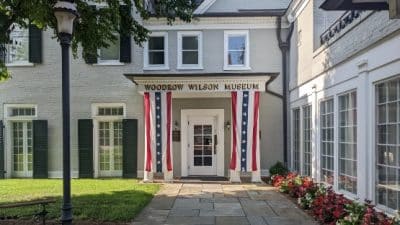U.S. Senator Ben Cardin (D-Md.), a senior member of the Senate Environment and Public Works Committee, Representative John Sarbanes (D-Md.-03), a member of the House Committee on Energy & Commerce, and Representative Rob Wittman (R-Va.-01), a senior member of the House Committee on Natural Resources, have introduced legislation in both the Senate (S. 1430) and the House of Representatives (H.R. 3063) to reauthorize the Chesapeake Gateways and Watertrails program run by the National Park Service.

Original cosponsors of the Chesapeake Gateways and Watertrails reauthorization include: Tom Carper, ranking member of the Senate Environment and Public Works Committee, and Chris Coons (both D-Del.), Chris Van Hollen (D-Md.), Mark Warner and Tim Kaine (both D-Va.). In the House, original cosponsors include: Steny H. Hoyer (D-Md.-05), Elijah Cummings (D-Md.-07), Dutch Ruppersberger (D-Md.-02), John K. Delaney (D-Md.-06), Bobby Scott (D-Va.-03), Gerry Connolly (D-Va.-11), Jamie Raskin (D-Md.-08), Barbara Comstock (R-Va.-10), Scott Taylor (R-Va.-02), Anthony G. Brown (D-Md.-04), Don Beyer (D-Va.-08).
“The Chesapeake Bay is the economic, historical and cultural heart of our region. The Chesapeake Bay Gateways and Watertrails Network is instrumental to making the entire Bay experience accessible, attractive and enjoyable for Marylanders and all Americans,” said Senator Cardin. “I am proud of our regional effort to continue federal support for this important program supporting the natural gateways to the Chesapeake Bay, despite the president’s efforts to zero out funding.”
“The Chesapeake Gateways program is an important federal vehicle for safeguarding public parks, trails, wildlife refuges, museums and historic sites that are part of the Chesapeake Bay Watershed,” saidCongressman Sarbanes, co-chair of the Chesapeake Bay Watershed Caucus. “These public spaces not only play a key role in the restoration and protection of the Bay, but also provide residents with more access and deeper connections to it. In order to inspire the next generations of citizen stewards and to ensure that the Bay remains an environmental treasure for future generations, we must support important initiatives like the Gateways program.”
“I’m passionate about restoring and preserving the Chesapeake Bay. It’s always a good day when we can come together in a bipartisan fashion to recognize the historical, cultural, and recreational significance the Bay provides to millions in the watershed,” said Congressman Wittman. “The Chesapeake Gateway and Watertrails Program will help sustain the Bay as an economic driver for our region and ensure visitors to the watershed area recognize the Bay as the national treasure that it is.”
The Chesapeake Gateways and Watertrails Network is a state, local, and federal partnership of 172 Chesapeake sites, parks, wildlife refuges and water trails that offer interpretation, education, youth employment, recreation, public access to the Chesapeake Bay and rivers, and trailheads for the Captain John Smith Chesapeake and Star-Spangled Banner national historic trails. Originally authorized as a pilot program in 1998, the program has been reauthorized several times since. The program was most recently reauthorized through 2013 in the Consolidated Appropriations Act of 202.
“Not only is the Chesapeake Bay an economic engine and an environmental resource that millions across our region depend on, it is a national treasure that all Americans should be able to enjoy,” said Senator Carper. “I’m proud of the bipartisan, regional support for the Gateways and Watertrails program, which will help to ensure that residents and visitors alike can appreciate all the Bay has to offer for years to come.”
“The Chesapeake Bay watershed is one of our greatest natural resources, providing wonderful recreational opportunities and supporting the livelihoods of millions across our region,” said Senator Coons. “Thousands of visitors from around the country visit our region to immerse themselves in our breathtaking natural landscapes and experience all of the natural, cultural, and historic sites the Chesapeake has to offer. I am proud to be an original co-sponsor of the bipartisan reauthorization of the Chesapeake Gateways and Watertrails program.”
“To experience the Chesapeake Bay is to understand the importance of preserving this natural treasure,” said Senator Van Hollen, member of the Senate Appropriations Committee. “For recreation and for Maryland jobs, a clean and thriving Bay is essential. We must maintain access to the Bay and its tributaries to keep the Bay healthy, and we must support the Chesapeake Bay Gateways and Trails program so families can continue to make memories on its waters and shores for generations to come. I’m happy to be part of this important, bipartisan effort to boost tourism and preserve the heritage of the Chesapeake Bay and its watershed.”
“The Gateways and Watertrails Program helps locals and visitors alike experience the rich cultural footprint of the Chesapeake Bay,” said Senator Warner. “It not only supports education about the Bay’s history and ecology, but also helps power the revenue-generating regional engine that is the Chesapeake Bay – which is why its reauthorization has bipartisan support across the region.”
“This program has opened greater public access to the Captain John Smith Trail and other jewels of the Chesapeake Bay, improving both quality of life and the regional tourism economy,” Senator Kaine said. “I’m proud of our bipartisan work to support this initiative.”
“I’m pleased to join my colleagues in reintroducing legislation to reauthorize the Chesapeake Bay Gateways and Watertrails Network,” said Congressman Hoyer. “The Gateways program provides critical funding that allows visitors to access the Bay in order to engage with the culture and history of our region. The health of the Chesapeake Bay is of critical importance to communities across Maryland, and the Gateways program helps raise awareness about the significance of the Bay to our region and the need to fulfill our shared goal of restoring it. I will continue to work with my colleagues in Congress to reauthorize the Gateways program and protect the Bay for years to come.”
“My congressional district lies at the mouth of the Chesapeake Bay on the banks of the James, Nansemond, and Elizabeth Rivers, presenting both challenges and opportunities,” Representative Scott said. “The Chesapeake Bay Gateways Network will preserve the natural beauty and cultural heritage of the bay through the help of grants, technical assistance to parks, volunteer groups, wildlife refuges, historical sites, museums and water trails. This will help ensure that we protect the Chesapeake Bay and its watershed so that future generations will be able to enjoy the benefits of this iconic body of water.”
“The Chesapeake Bay is not only an economic driver in Maryland—supporting thousands of jobs across the state—it is a part of our way of life,” Congressman Cummings said. “This bill will ensure that residents are able to enjoy the Chesapeake Bay and learn about its rich history so it is cherished for generations to come.”
“As a House Appropriator and a Maryland native, this program is a no-brainer,” Congressman Ruppersberger said. “These grants help attract volunteers and visitors to the Chesapeake Bay, both boosting Maryland tourism and cultivating a deeper appreciation of one of our nation’s greatest natural treasures. We are essentially recruiting new stewards to help conserve the Bay for generations to come.”
“The Chesapeake Bay is a national treasure that we must protect for future generations,” said Congressman Connolly. “The Chesapeake Gateways and Watertrails program is an example of responsible, bipartisan stewardship we need if we are going to continue our progress in restoring the Bay.”
“I want to thank my colleagues, Senator Cardin and Congressman Sarbanes, for introducing legislation to reauthorize the Chesapeake Gateways and Watertrails program, which safeguards both the economic and environmental value of the Chesapeake Bay,” said Congressman Delaney. “The bay is a national treasure and an essential part of both the heritage and the economy of Maryland and I am proud to co-sponsor this bipartisan, bicameral effort to ensure the bay is protected, accessible, and sustainable for future generations to enjoy.”
“The Chesapeake Bay is a jewel for our entire region and this bipartisan, bicameral effort will help boost the Bay’s tourism economy while at the same time create jobs,” Congresswoman Comstock said. “The Bay continues to be an economic engine for the region and efforts to protect and continually clean-up the Bay will not only help the environment, but also many local economies. The Chesapeake Gateways and Watertrails Network is a great example of a multi-state federal partnership that encompasses 172 Chesapeake sites throughout the region and engages the public through education, youth employment, recreation, and public access to the Bay.”
“The Chesapeake Bay strengthens Maryland’s tourism industry, supports good paying jobs and generates billions of dollars of economic benefits, and is a source of immense pride,” Congressman Brown said. “The important partnership provided by the Chesapeake Bay Gateways and Watertrails program plays an integral role in protecting the Chesapeake’s natural and cultural heritage and ensuring future generations have access to the historic sites, lands, and water trails that tell our region’s story.”
“The Chesapeake Bay is the lifeblood of the Mid-Atlantic region,” Congressman Raskin said. “The ‘Gateways and Watertrails’ program opens the Bay up not just to millions of people who live in Maryland, Pennsylvania, New York, New Jersey, Delaware, West Virginia, the District of Columbia and Virginia, but to visitors from all over America and the world. Congress is ready to defend our essential historical investment in this essential natural asset.”
“The Chesapeake Bay is an iconic part of American history. The environmental and economic wellbeing of our region depends on it,” Congressman Taylor said. “This program is a bipartisan effort to preserve public parks, trails, wildlife refuges, and historic sites, while protecting recreational access for locals and visitors. By educating people on the importance of the Bay and its watershed, we can cultivate a respect and understanding for the value these natural resources provide to our region and communities. I am proud to be an original co-sponsor of this bill.”
Visitation at Chesapeake Gateways sites exceeds 10 million people annually, and the competitive grants program is oversubscribed every year. The National Park Service provides matching grants between $5,000 and $50,000 for projects that enhance public education of and access to the Chesapeake Bay. Only sites that have gone through a rigorous review process and have been formally selected as part of the Gateway and Watertrails Network are eligible for the competitive grants.
The Chesapeake Bay is the largest estuary in North America, with a length of 200 miles and 11,684 miles of tidal shoreline, more than the entire U.S. West Coast. About 100,000 streams and rivers thread through the Chesapeake’s 64,000-square-mile watershed, which is home to almost 17 million people across Maryland, Virginia, Delaware, Pennsylvania, West Virginia, New York and the District of Columbia.










